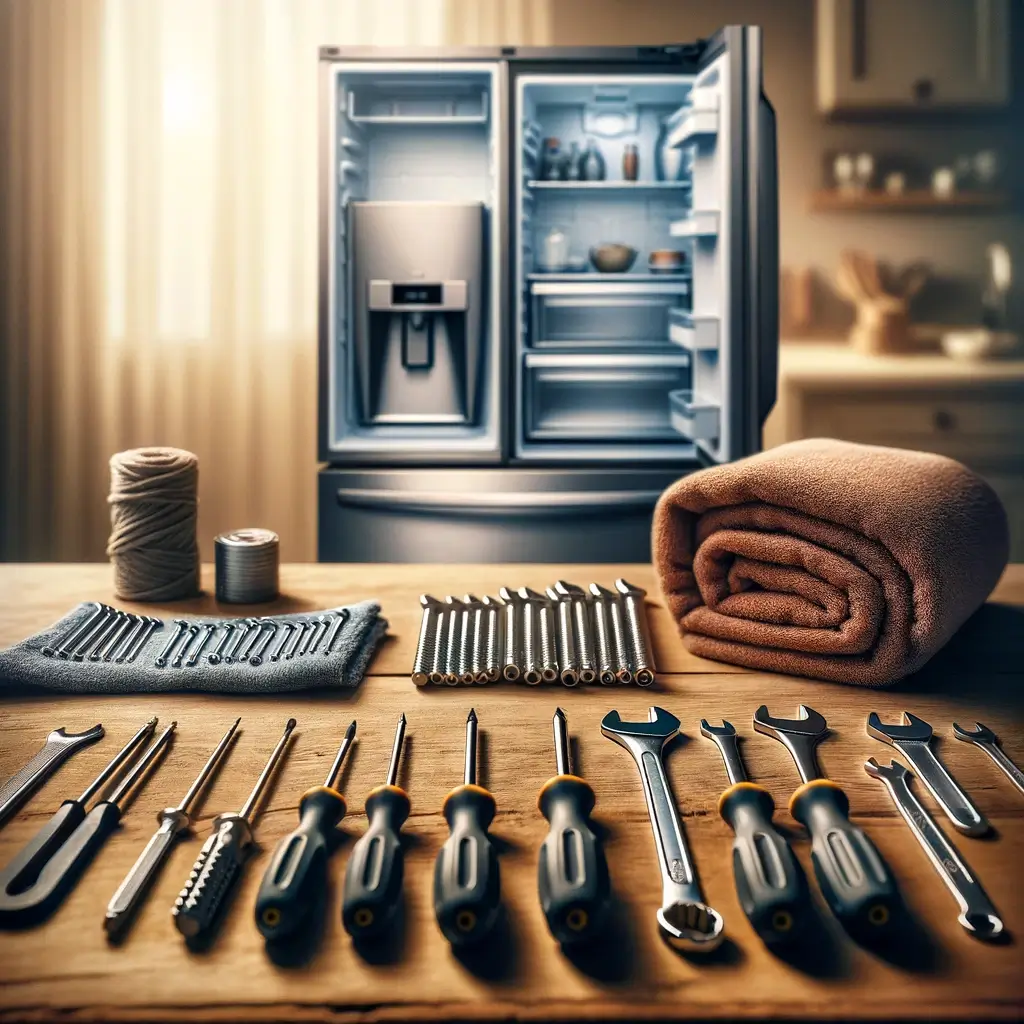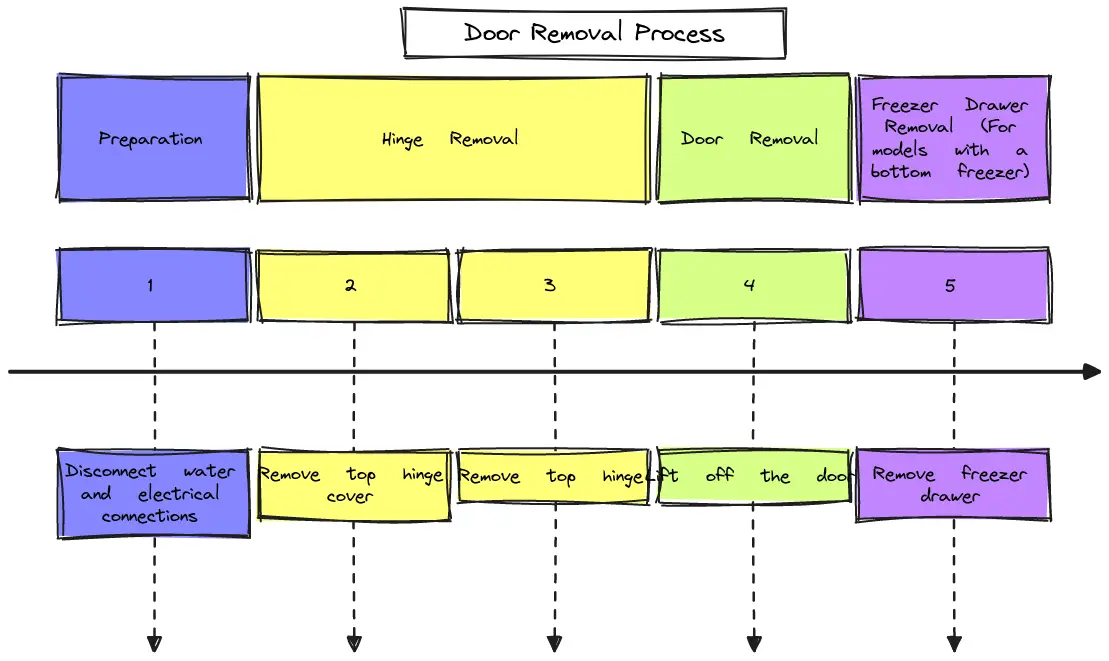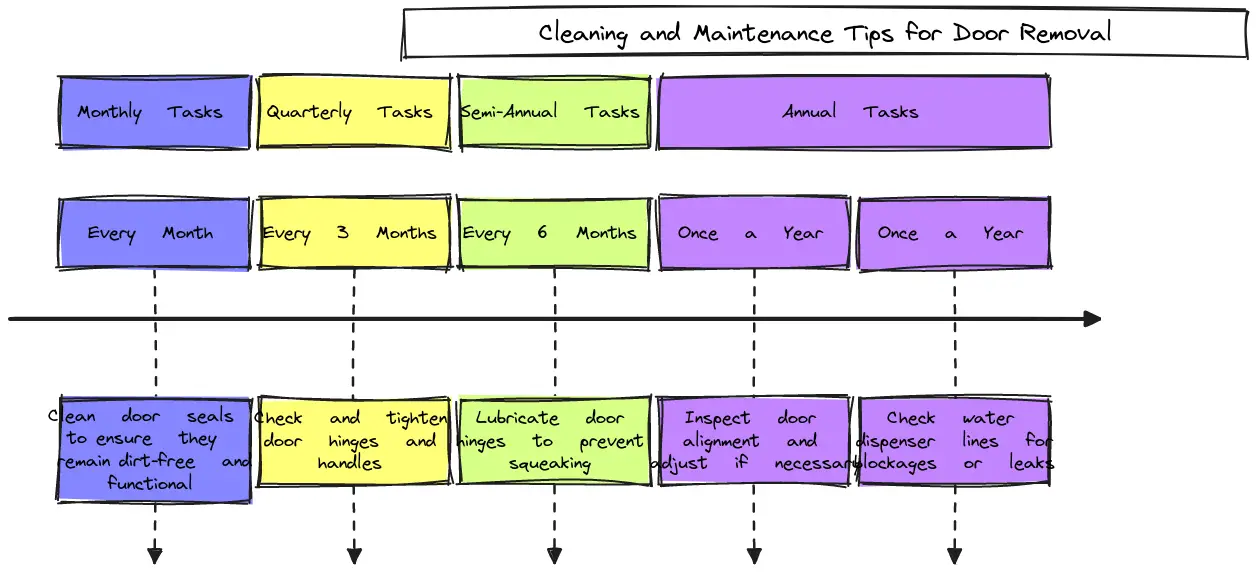I’ve researched the ins and outs of “How to Remove Doors From LG Refrigerator,” making this daunting task approachable for anyone.
Whether you’re moving, deep cleaning, or servicing your fridge, knowing how to safely take off those doors can save you time and hassle.
The process is simpler than you might think, and I’m here to guide you through each step.
Armed with some basic tools and a bit of patience, you’ll be able to handle this project with confidence.
Our journey begins with the right tools and a detailed guide to ensure we handle our appliance with care, avoiding any damage or scratches.
Let’s dive into the specifics, where every step is crucial for a successful door removal.
Preparing for Door Removal

Before we dive into the nitty-gritty of removing the doors from your LG Refrigerator, let’s gather our tools and take some necessary safety precautions. It’s like preparing for a culinary masterpiece; every utensil and safety measure is crucial to the outcome.
Tools and Materials Needed
Imagine you’re an artist, and your LG refrigerator is your canvas. Here’s what you’ll need in your toolkit:
- Screwdrivers: A Phillips head and a flat-head, for those tiny dancers known as screws.
- Wrenches: For any stubborn nuts and bolts that hold the door in place.
- Protective Gloves: To keep your hands safe and clean. Think of them as your kitchen mittens for the cold.
- Towel or Blanket: To lay the door on once removed, preventing scratches or damage.
Safety Precautions and Preparation Steps
Now, let’s talk safety and prep, the mise en place of our task:
- Unplug the Refrigerator: Unplugging ensures we’re not playing with electricity.
- Empty the Contents: Remove all items from the door shelves and the refrigerator itself. It’s like clearing the stage before a performance.
- Protect Your Floor: Place a towel or soft cloth on the floor. It’s not just for spills; it’s to protect your floor when you remove the door.
- Secure a Helper: Doors can be heavier than they look. Having someone to assist you is like having a sous chef in the kitchen.
How to Remove Doors from Your LG Refrigerator
Removing the doors from your LG refrigerator can seem like a daunting task.
Whether you’re moving, performing deep cleaning, or just trying to fit your appliance through a narrow doorway, understanding the right way to dismantle those doors without causing damage is crucial.
I’ll guide you through each step, incorporating advice from appliance repair experts and insights drawn from user testimonials.
Disconnection of Water and Electrical Connections

Before we start with the physical dismantling, it’s essential to ensure your refrigerator is disconnected from any water and electrical sources.
This step is crucial for models equipped with ice makers or water dispensers.
- Locate the tubing disconnect on the upper rear portion of the refrigerator.
- Press the collar on the elbow connector and pull the tube away to disconnect it.
- Unscrew the tube cover and set it aside, exposing the internal connections.
Removal of Top Hinge Cover and Hinge
With the fridge safely disconnected, we’ll move on to removing the upper doors’ hinges.
- Locate and remove the screw that secures the hinge cover to the top of the refrigerator.
- Disconnect all wire harnesses carefully to avoid damaging the connections.
- Lift the hinge lever counterclockwise to release the lock and remove the top hinge.
Lifting Off the Door
Now, the moment of truth – removing the door.
- Be mindful of the door; it is no longer attached to the hinge and can easily fall.
- Lift the door from the hinge pin carefully and set it aside on a safe, non-scratch surface.
Freezer Drawer Removal (For Models with a Bottom Freezer)
If your LG fridge features a bottom freezer, here’s how to tackle the drawer removal.
- Start by removing the lower basket, and lifting it off the rail system.
- Locate and unscrew the two screws that hold the drawer to the rail.
- Grasp the door on both sides, lift, and pull out to remove it from the rail mechanism.

Reattaching the Doors on Your LG Refrigerator: Step-by-Step Guide

Reattaching the doors of your LG Refrigerator is a task that many of us might approach with a bit of hesitation.
I’m here to walk you through each step, ensuring your refrigerator’s doors are not only back in place but also fully functional and aligned, just like the day you first met.
Before You Start: A Quick Checklist
- Tools: Ensure you have a screwdriver on hand. The right tools make all the difference.
- Safety First: Always remember to handle with care. These components are the lifeline of your appliance.
- Preparation: Have a clean, sturdy surface ready to place any components you may remove.
Reconnecting and Aligning the Doors

Getting the Door Back on Its Hinges
- Start by positioning the door onto the hinge pin, located at the bottom bracket of your refrigerator. This is where the process begins.
- Next, carefully lift the top hinge over the hinge lever latch, guiding it into its rightful place. This may require a bit of finesse.
- With the hinge lever in hand, rotate it counterclockwise. This action secures the hinge into place, ensuring your door is firmly attached.
The Finer Details: Water Lines and Electrical Connections
- Water Line Reconnection: The tubing disconnect is found on the upper rear portion of the refrigerator. Here’s where precision matters. Push the water tube back into the tube channel, making sure it exits through the rear. This is crucial for the water dispenser to function correctly.
- Electrical Connections: Don’t overlook the wiring harnesses. Reconnecting them properly ensures all your refrigerator’s electronic features work as intended.
Troubleshooting Common Issues with LG Refrigerators Post Door Removal

After we’ve taken the step to remove our LG refrigerator doors, either for a move, to fit through a narrow space, or for a deep clean, putting everything back together might not always go as smoothly as planned.
Misalignment and Sealing Problems
When our refrigerator doors don’t quite seem to sit right, we’re looking at potential misalignment and sealing issues.
This isn’t just about aesthetics; it’s crucial for maintaining the fridge’s efficiency and ensuring our food stays fresh.
Steps to Realignment:
- Check the Hinge Lock Mechanism: First, ensure the top hinge is properly seated. We rotate the hinge lever counterclockwise to secure the hinge into place, which should align the door correctly.
- Adjust the Tension in Door Hinges: Sometimes, a slight adjustment in the tension can make all the difference. If the door seems off-kilter, tightening or loosening the screws can help realign it.
- Inspect Seals for Damage: Over time, the seals can wear out or get damaged. A thorough inspection might reveal the need for a replacement to ensure a tight seal.
Water Dispenser or Ice Maker Not Working
It’s a common hiccup; we put everything back together, and suddenly, the water dispenser or ice maker decides to take a day off.
Reconnection Checklist:
- Ensure Water and Electrical Connections Are Correct: We start by ensuring the tubing is securely reconnected by pressing the collar and pulling on the tube to check for a secure fit.
- Troubleshoot the Dispenser/Ice Maker: If it’s still a no-go, checking for any kinks in the water line or ensuring the water valve is turned on might uncover the culprit.
Unusual Noises
Those odd sounds coming from our fridge post-DIY project can range from mildly annoying to downright concerning.
Solving the Mystery Sounds:
- Securing Loose Components: Often, these sounds stem from something not being quite tight enough. A quick run-through, tightening all screws and ensuring every component is snug, can quiet things down.
- Balancing the Doors: If the noise persists, checking the balance of the doors and adjusting as necessary can eliminate any awkward, noise-causing friction.
Electronic Features Malfunction
In the age of smart appliances, a hiccup in electronic features post-door removal isn’t out of the ordinary.
Resetting Electronic Controls:
- After everything is back in place, a general reset of the refrigerator’s electronic system can help. This usually involves unplugging the fridge for a moment and then plugging it back in.
- When to Call in the Experts: If the reset doesn’t do the trick, it might be time to reach out to LG’s customer support. They’re the pros, after all, and can offer guidance specific to our model.
Maintenance Tips After Door Removal and Replacement
When we’ve taken the bold step to remove and reinstall the doors on our LG Refrigerator, ensuring it runs smoothly thereafter is crucial.
This guide draws on expert recommendations and the collective wisdom of DIY enthusiasts to help us keep our appliances in top shape.
Post-removal checks and Balances
First off, it’s vital to make sure everything is back in its right place. This includes:
- Ensuring the doors are properly aligned and the seals are flush against the frame to prevent cool air from escaping.
- Checking that all screws and bolts are tightened to avoid any wobbling or misalignment that could disrupt the refrigerator’s efficiency.
Cleaning and Maintenance for Optimal Performance

Cleaning the Seals
The seals around our refrigerator doors are crucial for maintaining the internal temperature. Here’s how to keep them clean and functioning well:
- Mix a mild soap solution with warm water.
- Use a soft cloth to gently clean the seals, removing any food residue or grime.
- Dry thoroughly with a soft cloth to prevent any moisture buildup which could lead to mold.
Hinge Area Maintenance
The hinges are the workhorses that bear the weight of our refrigerator doors. To keep them in good condition:
- Lubricate the hinges annually with a food-grade lubricant to ensure they operate smoothly.
- Check for any wear and tear, and tighten any loose screws or bolts.
Expert Recommendations and Citations
Experts from Appliance Repair Services and manufacturers alike stress the importance of regular maintenance. According to a survey by Consumer Reports, regular cleaning of the seals and hinges can extend the life of your refrigerator significantly.
Scientists from the Home Appliance Efficiency Studies emphasize the role of proper maintenance in energy conservation. A well-maintained refrigerator uses less energy, which is not only good for our wallets but also the planet.
Final Thoughts
In my research on “How to Remove Doors From LG Refrigerator,” I discovered it’s not just about following steps; it’s about understanding your appliance.
This task, which might seem daunting at first, is quite doable with the right tools and a bit of patience.
I found that the key lies in taking precautions and paying attention to the details, like disconnecting wires and handling hinges.
Troubleshooting common issues post-door removal taught me the importance of alignment and connection checks.
Each step is a learning opportunity, turning an intimidating job into a manageable DIY project.
Sources and References
- Appliance Repair Forum
- DIY Network
- AppliancePartsPros
- RepairClinic